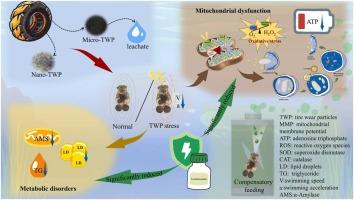Metabolic saboteurs: Tire wear particles hijack energy economy of zooplankton
IF 11.3
1区 环境科学与生态学
Q1 ENGINEERING, ENVIRONMENTAL
引用次数: 0
Abstract
Tire wear particles (TWP) represent a significant source of marine microplastic pollution and have been shown to pose a considerable threat to marine organisms. In this study, the marine rotifer Brachionus plicatilis was employed as a model organism to systematically assess the effects of micron-sized and nano-sized TWP, as well as their leachates, on rotifer behavior, and underlying molecular mechanisms. The results revealed that TWP exposure significantly reduced rotifer motility, evidenced by decreased swimming speed and acceleration. Further investigation revealed that TWP-induced suppression of rotifer motility was mechanistically linked to metabolic disturbances (reduced amylase activity, triglyceride, and neutral lipid levels) and mitochondrial dysfunction (oxidative stress, ATP depletion, and autophagy activation). Concurrently, rotifers counteracted TWP-induced stress by activating oxidative stress responses and mitophagy pathways, while concurrently initiating compensatory feeding to alleviate energy depletion. Notably, N-acetylcysteine supplementation significantly mitigated TWP-induced mitochondrial dysfunction and metabolic disturbances. Furthermore, a significant dose-dependent decline in Biomarker Response Index (BRI) values was observed with increasing TWP concentrations. This study elucidates TWP’s toxic mechanisms in aquatic organisms and underscores low-concentration exposure risks, providing key evidence for assessing long-term ecological impacts of microplastic pollution.

代谢破坏者:轮胎磨损颗粒劫持浮游动物的能量经济
轮胎磨损颗粒(TWP)是海洋微塑料污染的重要来源,已被证明对海洋生物构成相当大的威胁。本研究以海洋轮虫臂尾轮虫(Brachionus plicatilis)为模型生物,系统评估了微米级和纳米级TWP及其渗滤液对轮虫行为的影响及其潜在的分子机制。结果表明,TWP暴露显著降低了轮虫的运动能力,证明是游泳速度和加速度下降。进一步的研究表明,twp诱导的轮虫运动抑制与代谢紊乱(淀粉酶活性、甘油三酯和中性脂质水平降低)和线粒体功能障碍(氧化应激、ATP消耗和自噬激活)有关。同时,轮虫通过激活氧化应激反应和线粒体自噬途径来抵消twp诱导的应激,同时启动代偿性摄食以减轻能量消耗。值得注意的是,补充n -乙酰半胱氨酸可显著减轻twp诱导的线粒体功能障碍和代谢紊乱。此外,随着TWP浓度的增加,观察到生物标志物反应指数(BRI)值显着的剂量依赖性下降。本研究阐明了TWP对水生生物的毒性机制,强调了低浓度暴露风险,为评估微塑料污染的长期生态影响提供了关键证据。
本文章由计算机程序翻译,如有差异,请以英文原文为准。
求助全文
约1分钟内获得全文
求助全文
来源期刊

Journal of Hazardous Materials
工程技术-工程:环境
CiteScore
25.40
自引率
5.90%
发文量
3059
审稿时长
58 days
期刊介绍:
The Journal of Hazardous Materials serves as a global platform for promoting cutting-edge research in the field of Environmental Science and Engineering. Our publication features a wide range of articles, including full-length research papers, review articles, and perspectives, with the aim of enhancing our understanding of the dangers and risks associated with various materials concerning public health and the environment. It is important to note that the term "environmental contaminants" refers specifically to substances that pose hazardous effects through contamination, while excluding those that do not have such impacts on the environment or human health. Moreover, we emphasize the distinction between wastes and hazardous materials in order to provide further clarity on the scope of the journal. We have a keen interest in exploring specific compounds and microbial agents that have adverse effects on the environment.
 求助内容:
求助内容: 应助结果提醒方式:
应助结果提醒方式:


